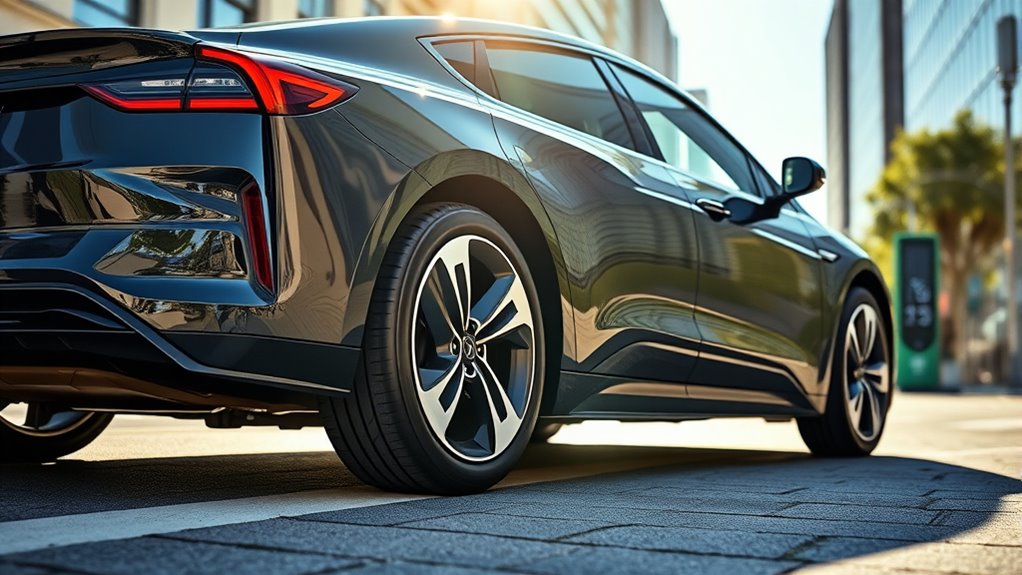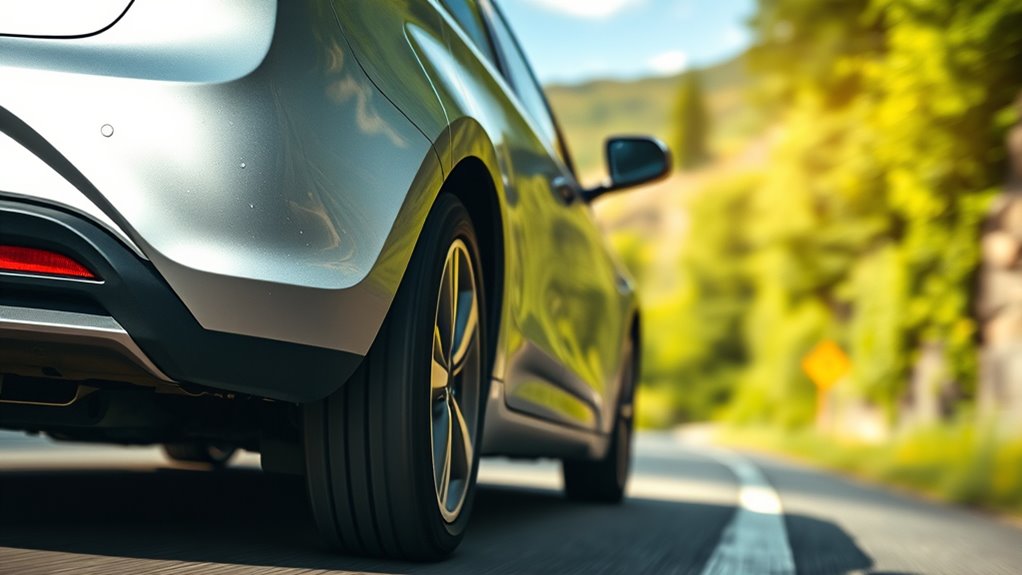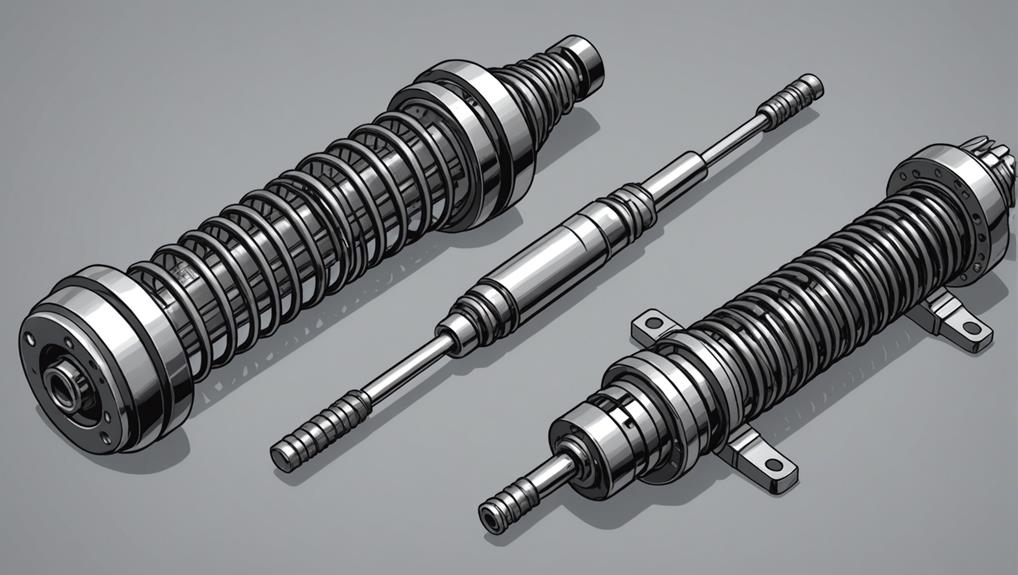Regenerative braking saves your car’s fuel by capturing the energy usually lost during braking and transforming it into electrical power. This energy is stored in the battery and reused during acceleration, reducing the workload on your engine and increasing fuel efficiency. It works automatically in urban stop-and-go traffic, lowering emissions and saving fuel over time. Keep exploring to discover how this smart system open up hidden savings and boosts your driving experience.
Key Takeaways
- Regenerative braking captures kinetic energy during deceleration, converting it into electrical energy stored in the battery.
- Stored energy is reused during acceleration, reducing reliance on the engine and saving fuel.
- Efficient batteries maximize energy recovery, increasing overall fuel economy.
- The system operates automatically, optimizing energy use without driver intervention.
- Reduced engine workload and energy waste lower emissions and extend vehicle component lifespan.

Regenerative braking is a technology that helps improve fuel economy by capturing energy usually lost during braking and reusing it to power the vehicle. When you hit the brakes, instead of dissipating all that kinetic energy as heat, your car’s system converts some of it into electrical energy. This process, called energy recovery, feeds the energy back into the battery, reducing the need for the engine to work as hard. As a result, your car consumes less fuel, making every trip more economical.
Regenerative braking captures energy during stops, boosting fuel efficiency and reducing emissions seamlessly.
The key to this system’s effectiveness lies in battery efficiency. A well-optimized battery can store and supply energy more effectively, ensuring that the recovered energy is readily available when you need it. When you brake, the system directs the electricity generated during deceleration straight into the battery, which then becomes a reserve of stored energy. This stored energy can be used later during acceleration or when driving at steady speeds, reducing reliance on the internal combustion engine. The better your battery’s efficiency, the more energy you can recover and reuse, amplifying the fuel savings.
You might not realize it, but regenerative braking works seamlessly in the background, constantly optimizing energy use without any extra effort from you. Every time you slow down or come to a stop, your vehicle’s system kicks in to capture that energy, which would otherwise go to waste. Over time, this process markedly reduces fuel consumption, especially in stop-and-go traffic or urban driving, where frequent braking occurs. It’s a smart way to extend your fuel range and cut down on emissions, all while maintaining the same driving experience.
Moreover, the efficiency of energy recovery depends on how your vehicle’s braking system is designed and how the battery interacts with the rest of the drivetrain. Advanced control systems ensure that the energy captured during braking is maximized without compromising safety or braking performance. When you accelerate again, the stored energy aids your movement, decreasing the load on the engine and improving overall fuel economy. This cycle of energy recovery and reuse is what makes regenerative braking such an innovative feature.
In essence, by enhancing battery efficiency and optimizing energy recovery, regenerative braking transforms how your vehicle manages power. It’s an intelligent system that saves fuel, reduces emissions, and extends the life of your vehicle’s components—all without you having to change your driving habits. It’s a simple yet powerful technology that’s quietly revolutionizing the way we think about energy and efficiency on the road.
Frequently Asked Questions
Does Regenerative Braking Work in All Types of Vehicles?
Regenerative braking doesn’t work in all vehicles. It’s mainly designed for electric vehicles and hybrids with compatible electric systems. If your vehicle has electric vehicle compatibility and hybrid system integration, regenerative braking can recover energy and boost efficiency. However, traditional gasoline cars without these features won’t benefit from regenerative braking. So, check your vehicle’s specifications to see if it’s equipped to take advantage of this eco-friendly feature.
How Does Regenerative Braking Impact Brake Maintenance?
Regenerative braking reduces brake pad wear because it uses the electric motor to slow your vehicle, taking some stress off the traditional braking system. This means you’ll experience less frequent brake pad replacement, lowering your maintenance costs. Overall, this system helps extend the life of your brake components and reduces the need for repairs, making your vehicle more cost-effective and reliable over time.
Can Regenerative Braking Be Manually Activated?
Imagine you’re driving and want more control—can you manually activate regenerative braking? Usually, it happens automatically when you lift off the accelerator, but some vehicles offer manual activation options, giving you driver control. You can engage it through specific settings or paddles, depending on your car’s features. This way, you decide when to maximize energy recovery, making your drive more efficient and tailored to your needs.
What Are the Limitations of Regenerative Braking in Winter?
In winter, regenerative braking faces limitations due to cold temperatures and poor road conditions. You might notice reduced efficiency because icy or snow-covered roads make braking less predictable, and the system struggles to recover energy when traction is compromised. Cold batteries also diminish energy storage capacity, meaning regenerative braking isn’t as effective. So, during harsh winter conditions, you’ll see that its benefits are somewhat limited compared to milder weather.
How Does Regenerative Braking Influence Long-Term Battery Health?
Did you know that regenerative braking can extend your battery’s longevity by reducing wear? It helps maintain battery health by optimizing charge cycles, which are vital for long-term performance. When you brake, energy is captured and reused, lessening strain on the battery. This process keeps your battery healthier over time, ensuring you get the maximum lifespan and reliable performance from your electric vehicle’s battery, saving you money and hassle.
Conclusion
Think of regenerative braking as a clever squirrel gathering acorns, storing energy for later use. Every time you brake, it’s like capturing a fleeting rainbow, turning it into fuel that keeps your car humming. This smart system turns your stops into savings, painting a picture of efficiency that keeps your wallet and the environment smiling. Embrace regenerative braking, and watch your fuel economy blossom like a garden in spring, thriving with every gentle stop.










